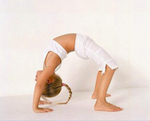The many benefits of yoga for kids
Posted on Friday, December 14, 2012 by: Victoria Moore
Posted @ Learn more: http://www.naturalnews.com/038345_children_yoga_benefits.html#ixzz2F2b9PJT1
Many children live a fast paced lifestyle between school, busy parents, sports and activities. It may not seem like it, but they are inundated with stresses such as peer pressure, competition, finding balance and over stimulation. Teaching yoga to children at a young age has tremendous health benefits and can give them the means they need to handle many life situations.
Help grow the body, mind and soul
Physical benefits include increased strength, flexibility, body awareness and coordination. Yoga helps to improve concentration and relaxation. It is a powerful tool to help children obtain a sense of calmness and develop a connection with themselves and the world around them. The ancient practice of yoga uses breathing, postures and meditation as a way to stimulate the parasympathetic nervous system resulting in a strong mind-body connection. Research has shown a decrease in symptoms for practitioners who had been diagnosed with epilepsy, depression and other stress related disorders.
In a 2003 study, California State University, Los Angeles found that yoga improved students’ behavior, academic performance and physical health. Establishing a regular yoga practice is important for children of all ages and works to improve gross motor development, agility, cooperation and allows them to feel comfortable with their body as it experiences changes. Children do not need to be a certain age to begin yoga. It can be introduced to infants to instill the power to control and regulate their emotions resulting in a happier, healthier child. Starting yoga young allows one to maintain the flexibility we are all born with, using deep breathing and postures to combat life experiences and stress that weigh on our body over time.
Teenagers and children with behavioral problems benefit greatly from yoga by reducing symptoms associated with attention disorders and hyperactivity. It helps them to strengthen intrapersonal and interpersonal communication skills, which are vital as they grow.
Schools and parents have an opportunity, and responsibility, to teach healthy initiatives to young children to help them deal with the challenges of childhood. Integrating a yoga practice into young children’s lives is easier now than ever before thanks to yoga videos, books and local yoga classes. Giving children the gift of yoga not only helps to prevent obesity and Type II diabetes; it also helps to develop their social, emotional and academic abilities. It is a good compliment to most sports and activities as a way to increase focus and prevent injuries.
There was recent controversy in a Southern California elementary school in which parents were complaining about the twice a week yoga program being offered, accusing it of religious indoctrination. It is important to understand how yoga can foster the mind, body and spirit without violating someone’s individual beliefs. Yoga teaches mindfulness with the intention of improving learning, while supporting the health and well-being of students and teachers. It encourages loving oneself and others as a practice of human compassion. Instilling this knowledge early in life helps lead to a generation of well-balanced beings.
Sources for this article include:
M.S. Kiselica, S.B. Baker, R.N. Thomas, and S. Reedy, “Effects of Stress Inoculation Training on Anxiety, Stress, and Academic Performance Among Adolescents.” Journal of Counseling Psychology 41, no. 3 (1994): 335-342.
T. Norlander, L. Moas, and T. Archer, “Noise and Stress in Primary and Secondary School Children: Noise Reduction and Increased Concentration Ability Through a Short but Regular Exercise and Relaxation Program,” School Effectiveness and School Improvement 16, no. 1 (2005): 91-99.
Nicole Klimas, “Yoga for Youngsters,” Advance for Physical Therapists and PT Assistants (2003), http://physical-therapy.advanceweb.com
http://www.ncbi.nlm.nih.gov/pubmed/22365651
